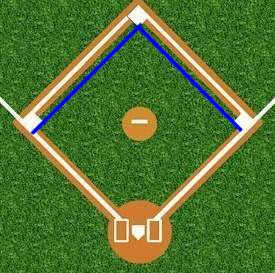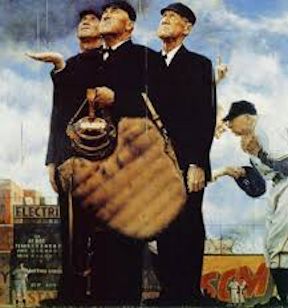Fair and foul, and a bit on the foul tip
I get a lot of questions from readers and it’s instructive reading and answering these questions that coaches, players, and umpires have about baseball rules and rules interpretations. It doesn’t take long to discover that, while most of the rules of baseball are rather straightforward, there are a great many cases where, in the course of a given play, quirky situations occur that make applying the rules more difficult. In other cases, there are simply misunderstandings about the rules and their application. (For more on this point, see the section Baseball Rule Myths.)
This is where the questions from readers become so helpful. They expose the quirky situations and misunderstandings about the rules and provide us with a useful rules education.
In today’s post we’re going to focus on one of the most basic aspects of the game: fair/foul. This is a pretty fundamental aspect of the game, and is pretty well understood by anyone who plays the game (or watches the game, for that matter), but there are a handful of nuances that sometimes throw people off. Let’s dive in.
The starting point for any discussion like this is the rule book — the Official Baseball Rules (OBR). In the OBR, "foul ball" and "fair ball" are defined in the section Definition of Terms. I encourage you to review the definitions entries for both Fair Ball and Foul Ball, and you may even with to have a look at our article Foul Ball/Foul Tip.
The first question comes from Neil and addresses a point about calling fair/foul that comes up a lot. The question refers to a softball game but the rule is identical in baseball:
Well, the umpire definitely got this one right. A bounding ball inside the base lines (that is, did not pass first or third base in flight) is always judged fair or foul by the position of the ball when first touched by a fielder. It doesn’t matter whether the fielder is on fair territory or foul. If the ball, when first touched, is over foul territory, it’s a foul ball; if first touched while over fair territory, it’s a fair ball. End of story.
It's surprising how often this comes up, usually from fans in the stands. I think it may have to do with our appreciation of spectacular sideline catches in football, where a receiver is on tiptoes on the sideline reaching out of bounds to make a highlight reel catch. Viewers are conditioned by this to anticipate the same in baseball. But it ain't so.
Let's double back and take a closer look at the rulebook definitions of Fair Ball and Foul Ball. Let’s see if my explanation matches the rules, starting with Fair Ball. Here’s a portion of what we find:
Okay, so far so good. The rule is clear: it doesn't matter where the fielder is. You judge fair/foul by the position of the ball when first touched.
Notice that the rule specifies a "fair fly"; all fly balls are judged this way — that is, by the position of the fielder when the ball is first touched. But bounding balls are different. In the question we discussed above, we're talking about a bounding ball, not a fly ball, but so long as the bounding ball is first touched by a fielder while it's inside the bags, it’s handled the same way as a fly ball. But let’s stop for a moment and ask what I mean by "inside the bags." This is important.
 Take a look at this image of the infield and take note of the blue lines that run along the front edge of first base and third base, meeting at second base. Think of these blue lines as though they were sheets of glass that are standing upright facing the batter. Any fair batted ball that does NOT touch the glass is said to be "inside the bags" and therefore must be touched by a fielder (or come to rest) before it can be judged to be fair or foul.
Take a look at this image of the infield and take note of the blue lines that run along the front edge of first base and third base, meeting at second base. Think of these blue lines as though they were sheets of glass that are standing upright facing the batter. Any fair batted ball that does NOT touch the glass is said to be "inside the bags" and therefore must be touched by a fielder (or come to rest) before it can be judged to be fair or foul.
On the other hand, any batted ball that bounds (touches the ground) inside the bags and then bounds through the glass (shattering the glass, which is in fair territory) is a fair ball, even if its path beyond the glass takes it over foul territory. In a nutshell, any bounding ball that crosses the bag (breaks the glass) is a fair ball.
That's different from how we judge fly balls in the outfield (that is, the ball flies over the glass). If the fly ball in the outfield first touches the ground in fair territory, it's a fair ball. If it first touches the ground in foul territory, it's a foul ball. Easy peasy.
But what if a fly ball in the outfield is touched by a fielder before it touches the ground? Well, then you have the same situation as in the infield. That is, if the fielder first touches the fly ball while the ball is over fair territory, it’s a fair ball. If the fielder first touches the fly ball while the ball is over foul territory, it’s a foul ball. Pretty simple.
This only gets tricky in that situation where the fly ball in flight is coming down near a foul line, and a fielder is charging full speed to intercept the ball and then just barely reaches the ball right at the line, touches the ball but fails to catch it. Those situations are really hard if the fielder's first touch is right at the line while he's running full speed. Without video reply it can be really hard to know for sure if the ball is fair or foul if it's touched with the fielder running full speed right at the line. You just have to make a call.
And don't forget, foul lines are fair territory. The foul pole (if you have one) is fair territory. First and third bases are both fair territory. And home plate, too, is also fair territory.
And here's another question about an unusual, rare fair/foul situation:
Well, again the umpire got this one right. So long as no fielder touched the ball, this is simply a case of a batted ball inside the bags that ends up in foul territory. So long as the ball comes to rest, hits a fence, or is first touched while in foul territory, you have yourself a foul ball. Same is true if a batted ball that hits first or third base and then ricochets into foul territory without crossing the bag. Foul ball. Of course, if the ball ricochets off the rubber or any of the bases and then continues past the bags (breaks the glass) before going into foul territory, you have a fair ball.
On a side note, I'd like to call attention to a detail of the definition of a foul ball that sometimes throws people off. I'm talking about the case where a fielder catches a fly ball for an out over foul territory. It happens all the time, those little pop ups near the dugout or down the line, or the ones behind home plate that the catcher gets. You'll sometimes hear someone comment that the fielder "caught a foul ball for an out." But that’s not true.
The definition of a foul ball has many parts (you can read it here), but all of them refer to the ball settling on the ground in foul territory, or touching a fielder or umpire or "any object foreign to the natural ground." What this comes down to, in a nutshell, is that a ball is not a foul ball until it touches the ground or a player (or fence or backstop, or whatever "object foreign …") over foul territory. Therefore, a fly ball that is caught over foul territory is not a foul ball. It’s just a fly ball caught for an out. It's not a foul ball, so the ball is live and runners can advance (after tagging up, of course). In fact, with a runner on third base, when a fly ball over foul territory is well beyond first base, you'll sometimes see a fielder intentionally not catch the ball. This is because if the ball drops it’s foul, the ball is dead, and the runner must stay on third. If it's caught, it’s not a foul ball, the ball is live, and the runner on third can advance to home scoring a run.
We can't leave the topic of foul balls without touching on the foul tip. It's astounding to me how much misinformation and confusion surrounds the difference between a foul ball and a foul tip. I hear seasoned announcers (some of them former major league players) see a foul ball go shooting over the catcher's shoulder and hit the umpire or else go straight to the fence behind home plate and they call it a foul tip. That's not a foul tip, it’s a foul ball!
Let me quote briefly from our article Foul Ball / Foul Tip (an article that you should definitely check out if you're even a little bit unsure about this):
And yet the confusion continues. So let's see what the Official Baseball Rules say (from OBR Definition of Terms: Foul Tip): "A FOUL TIP is a batted ball that goes sharp and direct from the bat to the catcher and is legally caught. It is not a foul tip unless caught and any foul tip that is caught is a strike, and the ball is in play."
If it's not caught it can never be a foul tip, but always a foul ball. And if the ball does not go "sharp and direct," that is, if the ball goes into the air at all and is then caught, that's neither a foul ball nor a foul tip: it's a caught fly ball, batter out.
Enough for now about foul balls. Again, if you’re interested in taking the subject even deeper, check out our article Foul Ball / Foul Tip.


